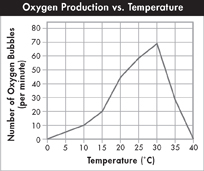Standardized Test Prep
Multiple Choice
Which of the following is a basic requirement of plants?
sunlight
carbon dioxide
water
all of the above
What stage in the alternation of generations is represented by fern fronds?
sporophyte
female gametophyte
male gametophyte
zygote
Which of the following is NOT a characteristic of dicots?
branched veins
taproot
parallel veins
two cotyledons
Which of the following is a structure associated with gymnosperms?
flower
cone
fruit
enclosed seed
The mature plant ovary is also referred to as the
gymnosperm.
pollen grain.
fruit.
cotyledon.
Plants cultivated for food are mostly
gymnosperms.
woody plants.
angiosperms.
bryophytes.
Questions 7–9
A group of students placed a sprig of a conifer in a beaker of water. They measured the amount of oxygen given off during a set period of time to determine the rate of photosynthesis. They changed the temperature of the water in the beaker using an ice bucket and a hot plate. Their data are summarized in the graph below.
What is the independent variable?
light intensity
temperature
oxygen bubbles
photosynthesis rate
Which variable(s) should the students have held constant?
plant type
temperature
light intensity
plant type and light intensity
What can you conclude based on the data?
The higher the temperature, the more oxygen bubbles are released.
There is an optimum temperature for photosynthesis in this species of conifer.
All plants are most efficient at 30°C.
The lower the temperature, the more oxygen bubbles are released.
Open-Ended Response
Explain why seeds were an important adaptation for the success of plants on Earth.
| Question | 1 | 2 | 3 | 4 | 5 | 6 | 7 | 8 | 9 | 10 |
|---|---|---|---|---|---|---|---|---|---|---|
| See Lesson | 22.1 | 22.2 | 22.4 | 22.3 | 22.4 | 22.4 | 22.3 | 22.3 | 22.3 | 22.3 |
Table of Contents
- Formulas and Equations
- Applying Formulas and Equations
- Mean, Median, and Mode
- Estimation
- Using Measurements in Calculations
- Effects of Measurement Errors
- Accuracy
- Precision
- Comparing Accuracy and Precision
- Significant Figures
- Calculating With Significant Figures
- Scientific Notation
- Calculating With Scientific Notation
- Dimensional Analysis
- Applying Dimensional Analysis





